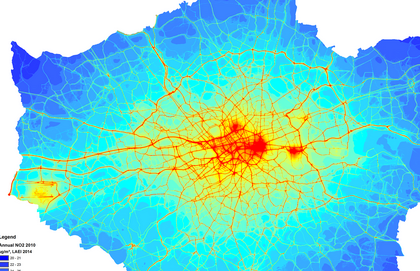In late July the Government published its Plan for tackling roadside nitrogen dioxide (NO2) concentrations, to reduce these below the statutory limit. Publication was met by considerable criticism that the Plan lacked urgency and effectively dumped the problem on the most affected local authorities, which would be required to implement Clean Air Zones (CAZ).
An accompanying 155-page Technical Report included, on its final page, new estimates of the economic benefits from reducing damage to health through measures to reduce NO2. Remarkably, these new estimates were very substantially below those that had been published in the Technical Report of May 2017 that accompanied the consultation preceding the Plan. For instance, the previous estimated health benefit of a further 21 CAZs was £3.6bn, but now is £620m – an 80% reduction.
This huge reduction was attributed to new advice from the independent experts of the Committee on the Medical Effects of Air Pollution (COMEAP), which had found it difficult to disentangle the impacts of specific pollutants, in this case NO2, from that of the whole mix of traffic related pollutants.
COMEAP’s previous advice recommended a central coefficient of 1.025 per 10ug/m3 NO2, which means that for every 10ug/m3 increase in NO2 concentration, the increase in mortality risk would be 2.5%. The revised advice now recommends a coefficient of 1.023 for traffic-related pollution; but COMEAP also recommends that when measures are primarily targeting NO2 emissions this coefficient should be adjusted to account for possible overlap between the direct impacts of small particulates and NO2. Applying their recommended adjustment, the resulting coefficient used for the analysis is 1.0092.
My enquiries of the Government’s Joint Air Quality Unit elicited the confirmation that overall the updated NO2 damage costs for road transport are approximately 80% lower than those used at consultation. This splits into roughly 60-65% resulting from the revised COMEAP advice and the remaining c.15-20% resulting from the other updates such as new dispersion modelling and population data. The JAQU confirmed that the reduction in the road transport NO2 damage cost primarily reflects a reduction in the estimated mortality impact associated with NO2 alone.
There has been widespread interest and concern about the health impacts of roadside air pollution over the past year and more. So it is surprising to learn of such a substantial downward revisions of official estimates of health impact. However, the relevance for policy is as yet unclear.
Current policy is driven by the need to avoid exceeding statutory limits for NO2 concentration laid down in a EU Directive that applies uniformly to all regions of the Community, in which context the scale of health benefits from remedial measures is not relevant. However, Britain is to leave the EU, which may open the possibility of regulation of air quality based on UK targets set to reflect the balance of benefits in relation to costs. A down rating of health benefits would then be relevant, particularly given the expected reductions in pollutants from improved vehicle technology and from the introduction of electric propulsion. Whether the Government would be willing to propose targets to reflect UK conditions remains to be seen – it may depend on the outcome of the Brexit negotiations and on a judgement about the politics of air pollution.
A version of this post was published in The Conversation on 30 August 2017
https://theconversation.com/no-not-as-bad-as-we-thought-83056

